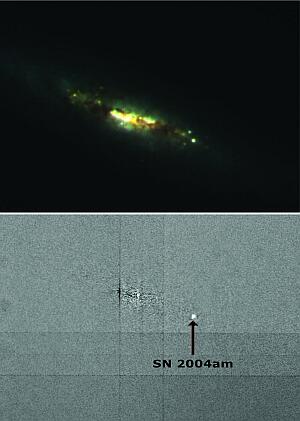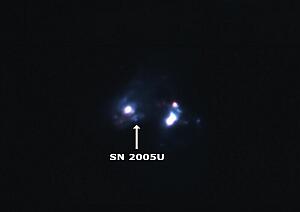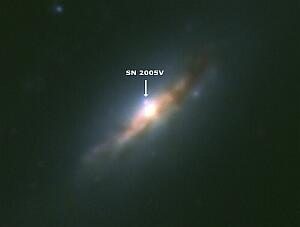A handful of nearby supernovae (SNe) with visual extinctions of a few magnitudes have recently been discovered. However, an undiscovered population of much more highly extinguished (A
V>10) core-collapse supernovae (CCSNe) is likely to exist in the nuclear (central kiloparsec) regions of starburst galaxies. For instance, in the nuclear regions of M82 and other nearby starburst galaxies one core-collapse supernova is expected to explode every 5-10 years. Furthermore, in luminous infrared galaxies (LIRGs) such as the interacting system Arp299 (NGC 3690+IC 0694) at least one CCSN can be expected every year.
The high dust extinction means that optical searches for such SNe are unlikely to be successful.
By observing in the near-IR Ks-band the extinction is strongly reduced, making searches for such dust obscured SNe look feasible. Making use of this advantage, astronomers have been carrying out a near-IR Ks-band search campaign for SNe obscured by dust in the nuclear regions of nearby starburst galaxies with the WHT since 2001. Initially, the search started using INGRID near-IR imager. In 2004 observations with LIRIS commenced. By that time, the search had only produced the detection of a possible SN in old images making any follow-up observations and definite confirmation of this SN impossible. They estimated that the lack of SN detections from the INGRID SN search database indicated an average extinction towards the nuclear SNe exceeding AV=10. Such high extinctions would certainly be expected for most of the SNe within the nuclear regions of starburst galaxies such as M82.
Already on the first run on 6 March 2004 LIRIS observed a SN, SN 2004am, within the nuclear regions (~500 pc) in M82. The discovery of this event, however, had already been reported just one day before the observations. The 0.89-1.53-ν LIRIS spectrum showed broad hydrogen lines demonstrating that this was a type II event. The LIRIS JHKs images showed a moderately reddened source exactly coincident with a bright starburst knot within the nuclear regions of M82. The optical-near-IR colours also showed that the extinction towards this SN was AV~5.

|
Figure 1.
Top: JHKs LIRIS image of M82 (+ SN
2004am) observed on 2004 Nov 25. Bottom: The result of alignment, image matching
and subtraction between LIRIS Ks band images from March 2004 and November 2004. Note that by this time the SN had already dimmed considerably. [ JPEG | TIFF ]
|
Later observations with LIRIS in 2005 produced discoveries of subsequently confirmed SN events in the interacting luminous infrared galaxy Arp 299 (distance ~45 Mpc) and in the nearby starburst galaxy NGC 2146 (distance ~13 Mpc). Both Arp 299 and NGC 2146 have high expected CCSN rates of ~1-2 and ~0.2 SNe per year, respectively, as indicated by their far-IR luminosities. SN 2005U with
Ks=16.2 was discovered 1.3 kpc from the
Ks-band nucleus A of Arp 299 and it was classified as a type II SN. The near-IR colour estimated from the LIRIS images gave an extinction of A
V~4. SN 2005V was also discovered by LIRIS on the same night. It had a magnitude of
Ks=13.8 and it was located 330 pc from the
Ks-band nucleus of NGC 2146. It was spectroscopically classified as a type Ib/c SN, about 1-2 weeks past maximum brightness. The near-IR colours from LIRIS indicated an extinction of A
V~3-4 towards SN 2005V.

|
Figure 2. JKs LIRIS image of Arp 299 (+SN 2005U)
observed on 2005 Jan 30. [ JPEG | TIFF ].
|

|
Figure 3. JHKs LIRIS image of NGC 2146 (+SN 2005V)
observed on 2005 Jan 30. [ JPEG | TIFF ].
|
The combined INGRID and LIRIS SN search database includes images for 40 nearby starburst galaxies, on average observed ~4.3 epochs per target. Although several CCSNe have now been discovered in starburst galaxies at near-IR wavelenghts, they are all extinguished by only a few magnitudes in A
V. The expected population of highly extinguished supernovae within the nuclear regions of starburst galaxies therefore still remains unrevealed.
References:
- S. Mattila, R. Greimel, P. Meikle, 2005, ING Newsl., 9, 16.
- S. Mattila, W. P. S. Meikle, R. Greimel, 2004, New Astronomy Reviews, 48, 595.
- The Nuclear Supernova Search
- S. Mattila, 2006, "Supernovas and brain imaging", Frontiers, 24, 8.

